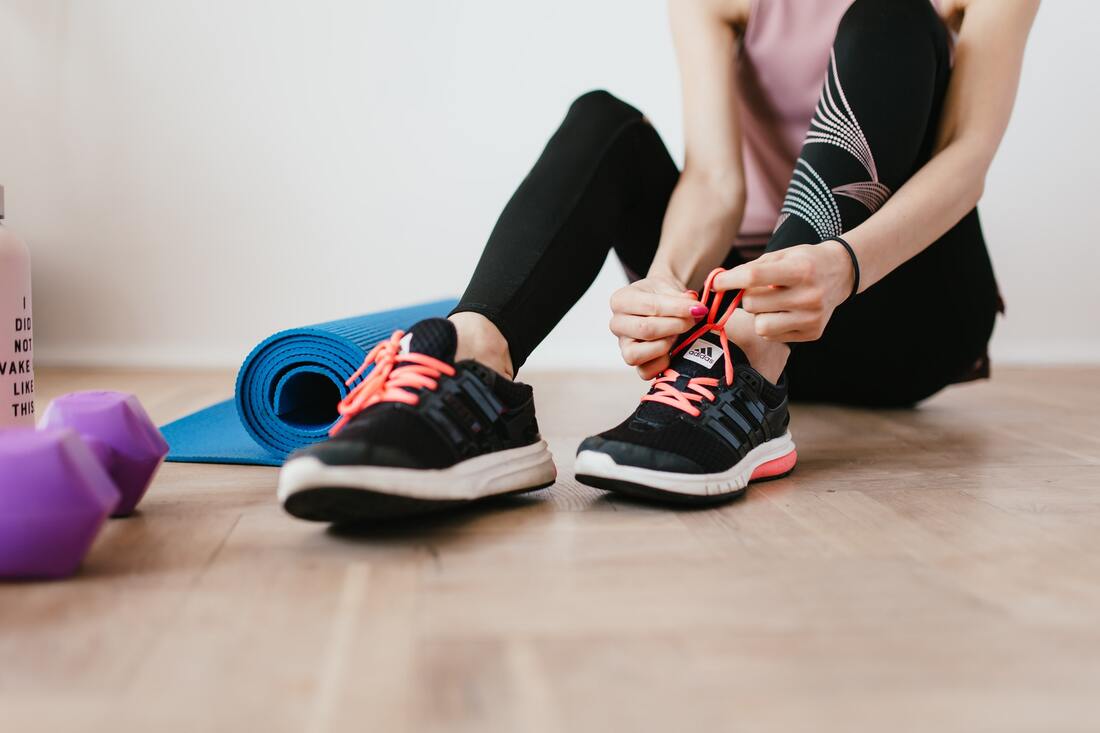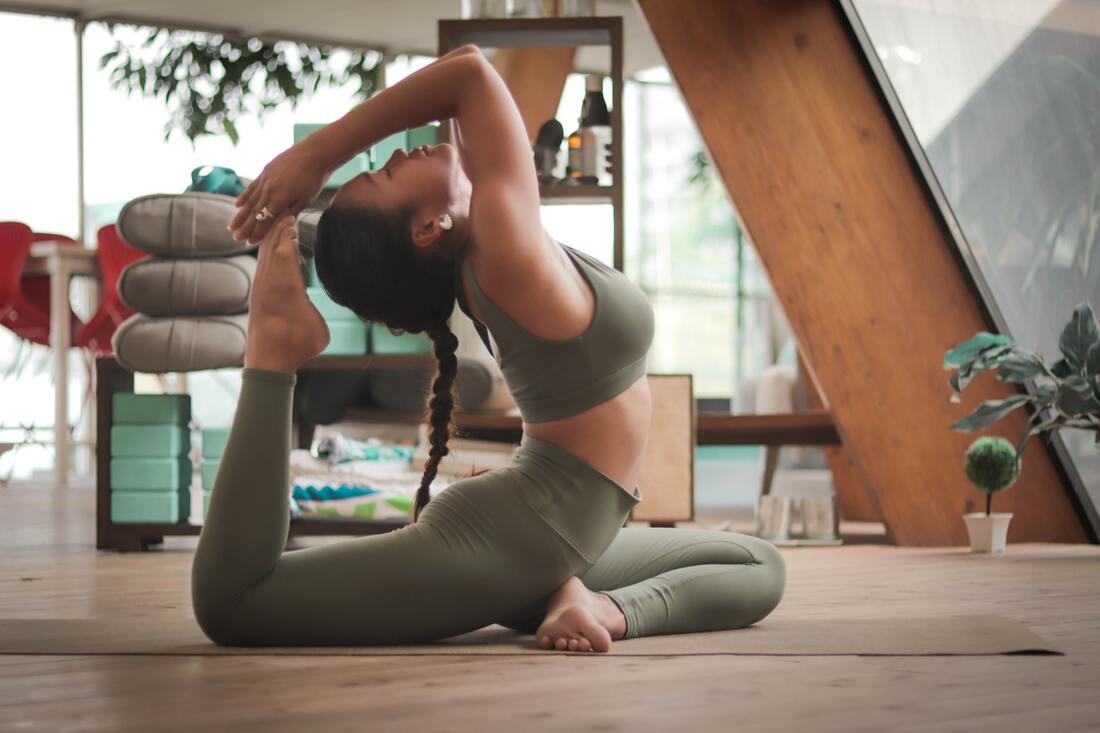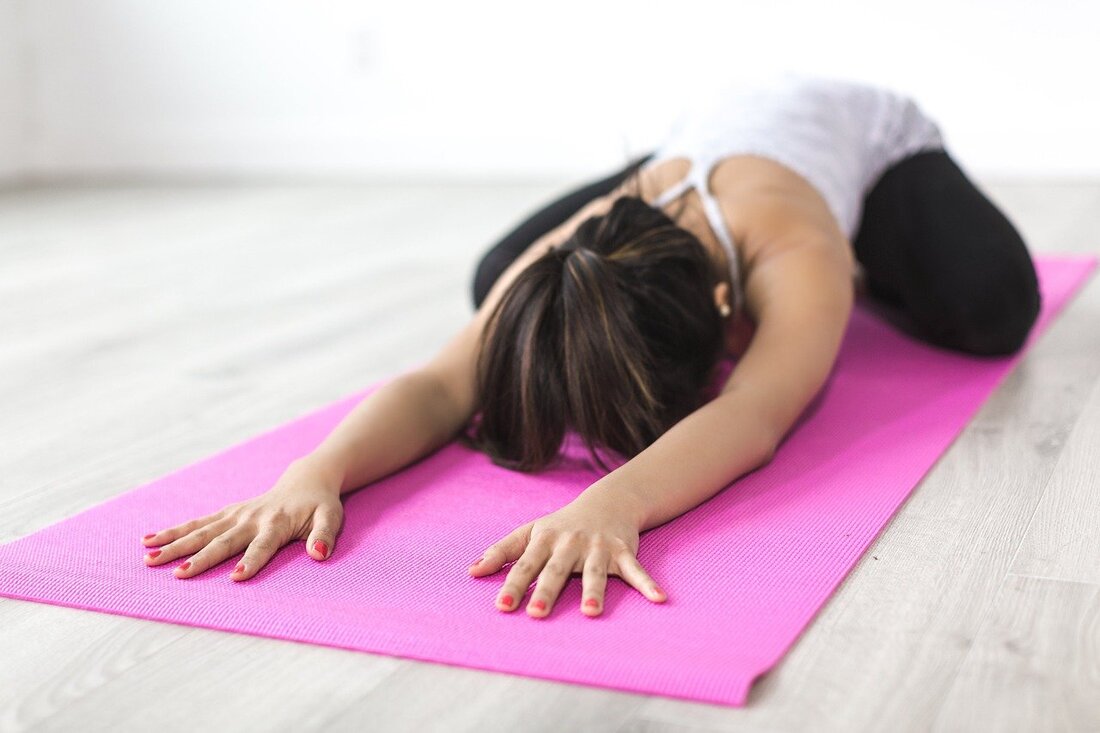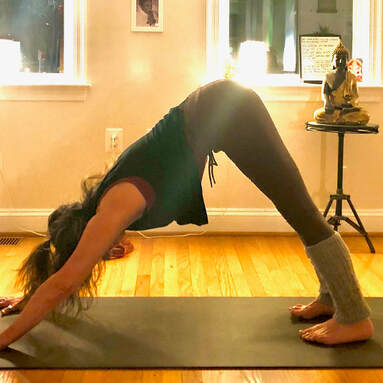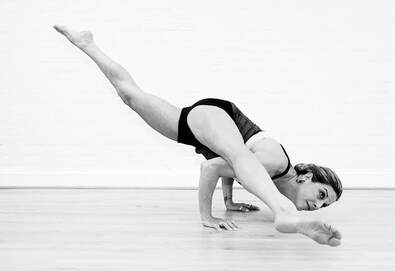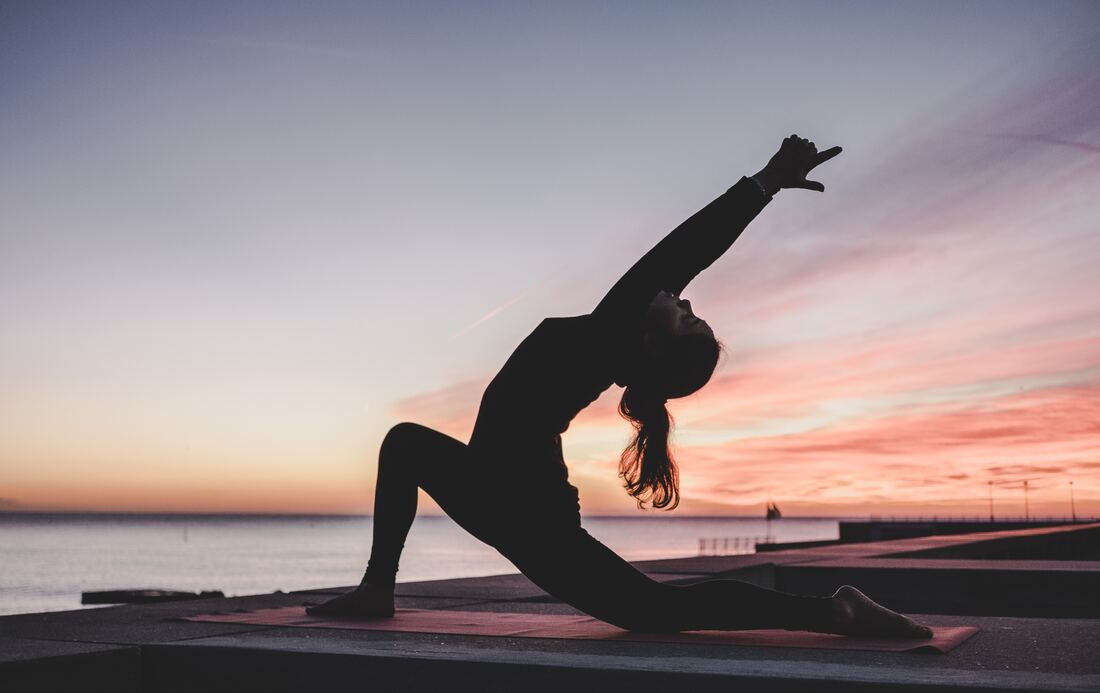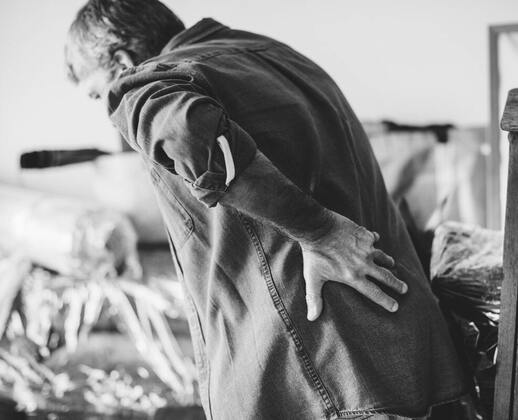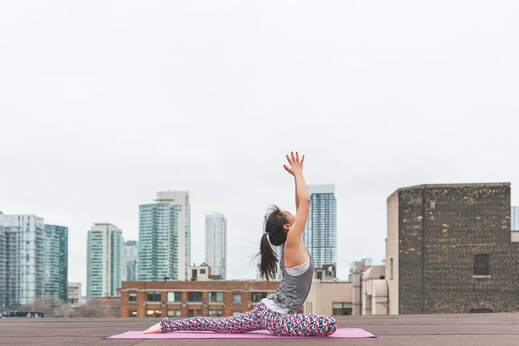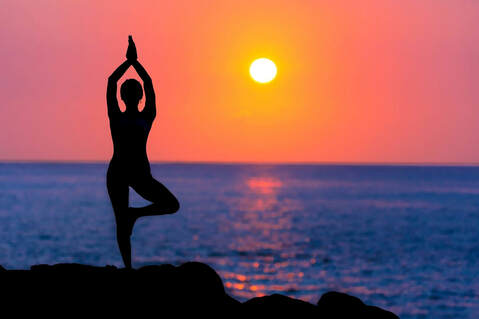|
Throughout the years, yoga has become one of the most popular disciplines in the US. In fact, TODAY reports that there were over 40 million yoga studios in the country in 2020, and 60 million yoga-related posts are generated on Instagram alone.
Indeed, though yoga has been an American obsession for more than a century, the pandemic has been driving its growth to new heights, with it being touted as a way of guarding, healing, and recovering from COVID itself. To aid them in this endeavor, yogis have literally been stepping up their game, ensuring sessions are comfortable and emphasize wellness. As previously discussed in our post on ‘6 Reasons to Start Doing Yoga in the Morning’, this will include working on enhanced focus and flexibility. They're doing so with a simple item: shoes. Yoga shoes are perfect for those who prefer not to practice with their bare feet, or those who want the support they provide when executing particularly challenging poses. However, not all shoes are created equal. This guide can help you find the right pair to wear for your yoga sessions. Mishansha Barefoot Yoga Shoes This particular Mishansha model does a great job at providing all the stability of the rubber shoe while maintaining the flexibility of the barefoot. These slip-on sneakers are beautifully breathable and even come with drainage holes in the sole, making them perfect for both yoga and water sports, or simply for those who tend to sweat profusely. AJ 1 Mid "Mindfulness" However, if you're comfortable with a more sneaker-like shoe, consider the AJ 1 Mid "Mindfulness." This pair was released when Nike and Jordan revealed their "Pregame Pack" Collaboration last year, and was designed with meditation and relaxation in mind. Thick-soled and tight fitting, these shoes give all the comfort you need. Its support reaches a couple of inches above the ankle, as well, meaning you're less likely to incur the strains and sprains so common in yoga. Bloch Contour Suede Yoga Shoes If you're bringing ballet into the yoga studio, these shoes, created by Australian dancewear company Bloch, are a perfect fit! Though first created for barre, a couple of tweaks have made these suede shoes, and they have become a favorite among yogis. This may be because of the shoes' sock-like feel which gives all the support you need to keep your balance. They're also uniquely made from neoprene, which helps them last longer. Vibram Alitza Loop Yoga Shoes For those who are looking for more unconventionally designed pairs, however, try the Vibram Alitza Loops. Holes for each individual toe mean the shoes have a more natural feel, so they can be worn anywhere from the grocery store to the yoga mat. Additionally, research published on Science Direct explains that shoes with EVA foam, which the Vibram Alitza Loops has, increases their durability. Therefore, expect this pair to last you years. Kicking it off The world of yoga shoes is large and ever-expanding, and all you need to do is go out there and explore it. From rubber shoes and sandals to "gloves" and sneakers, there are countless ways for you to bring your game to the next level. So whether you've been a yogi for decades or are just starting out, these shoes can help you step up to the mat and get kicking.
128 Comments
By Cassandra Rosas Link to original article.
Whether you are an avid yoga practitioner or completely new to yoga, sometimes you just need a moment with yourself to slow-down and relax, and this practice seems to be perfect for that purpose, to reconnect with your body through your breath, attention to movement, and to the present moment. If that is your case, you may be wondering how to create an ideal space at home that helps with relaxation and focus, which is why we gathered the expert’s advice on how to achieve that vibe at home and the recommended exercises to do safely, either on your own or following an online or a virtual yoga class. So keep reading to discover what the experts told us! Where would you set up a dedicated yoga space at home, and what do you need for this? The ideal space to practice is usually the quietest one. You don’t need lots of space but plenty of natural light is always good. Clear the space of clutter as much as possible – even if it’s only the area around your mat or the end of the room where you are practicing. The less distractions, the better. I always like to face a window as it’s lovely to have the sun on your face or be able to see the sky or trees. You just really need your yoga mat and props if you use them. A plant or two can really help to make the space feel calm and more relaxing. Use an essential oil spray and mist the space before you start. Spend time sitting and connect to your breath. By Nichi Green from The Yoga Space How can you create the perfect ambience in your yoga space to help with relaxation and concentration? In a perfect world, we would all have a room dedicated to our yoga practice -but in reality, we often have to tuck our mat between the bed and the wall. You can make the most out of your space, or lack thereof, by attending to lighting, props, and sound. Overly bright lighting can be overstimulating, so consider adding dimmers to your overhead lights or turning on a smaller light source such as a lamp. Your props will help to make your practice more comfortable, so make sure you have at least enough room to have them nearby. Ideally, you should have enough room on either side of you, not only for your props but also to take a supine twist on each side. Lastly, many people find music to be a soothing addition to their practice. Music can not only reduce the effect of distracting noises but also it can have a powerfully soothing effect on your nervous system. By Cristina M. Kuhn from Yoga Medicine® How would you achieve the ideal Zen vibe at home for your yoga practice? We would say there’s not one specific answer to this question, but overall you would need to make sure you create a corner or room with a totally different atmosphere. Don’t just start a yoga class in your living room or home office without changing some stuff around. Get out of your day to day surroundings and create a space where you can get extra zen and escape from everyday life. By Chris Bakker from Onefit Which yoga styles are best for trying at home? Restorative and gentle Hatha are the best for practicing at home. They are slower, so less likely to injure- Iyengar too if you know it. Ashtanga and vinyasa are more vigorous and only should be a home practice if you have already learned from an experienced teacher who has taught correct form, breathing, and focus. Nidra and yin can be done at home too, but it might be more beneficial to have someone guiding you online. Kundalini is quite challenging to do on your own, so I suggest online or using manuals if you have studied it before! Any of these forms can be found online if you are not versed enough to practice at home. However, if you are new to Yoga, the first two mentioned would be safest and very beneficial. By Donna Amrita Davidge from Sewall House Which aspects should we consider when picking the type of yoga to practice from home? When practicing yoga at home, there are a few things to keep in mind when selecting a class. First, I highly recommend that you attend classes with a live instructor (whether in-person or virtually) who has met you face-to-face. Visual information gives yoga teachers a lot of information about how we can help you align yourself in any given yoga position. Additionally, the relationship between an instructor and student is very important in your overall comfort and it’s difficult to build this without any live interaction. Although YouTube classes can be a great way to try out yoga, there is no denying that real progress usually comes from studying with a live teacher. Second, make sure the class you pick won’t utilize props you don’t have. Usually, we can give some ideas for DIY props you can use at home. But if you’re attending a Restorative or Yin class and don’t have some combination of pillows, blankets, bolsters, blocks, and/or straps, the class might be very challenging for you. If you pick a Yoga Burn class but don’t have any free weights, the class may not be challenging enough. If you don’t have a yoga mat, you can use a towel instead. Third, if you’re just starting out, very inflexible, or recovering from a significant injury, picking a very fast-paced or difficult class (level 2 or 3, power yoga, ashtanga yoga, etc.) may not suit your body just yet. You might prefer to start in a gentle, beginner, or level 1 class to get your bearings before you advance your practice so that you don’t hurt yourself. Remember, there’s no rush! Most importantly, practicing yoga should feel good. If you ever feel pain, back off and consult with a registered yoga teacher (RYT). By Erin Haddock from Five Keys Yoga, LLC What is the easiest style of yoga to start practicing at home as a beginner and should be taken into consideration? If you are new to yoga, welcome! When you first start, it’s great to work with a yoga teacher 1-on-1 so that they can access your current fitness level, help you to learn the correct breathing and poses, and help you work with any injuries or pre-existing conditions. If that is not accessible to you financially, I would recommend trying a slow flow class or a level 1 Hatha vinyasa class. If you don’t see these types of classes on your local studio’s schedule, reach out to the studio to ask them what the most beginner-friendly class is! Always make sure to let your yoga teacher know if you have any injuries or anything going on in your body so that they can help you modify poses. Once you are familiar with the basics of yoga, it’s great to try a variety of classes to see what you like most. By Amanda Kingsmith from Mastering the Business of Yoga What is the easiest yoga sequence for a beginner to do at home? An easy way to start your yoga practice at home is the traditional Sun Salutation A, which is a set sequence of yoga poses that are linked to each other in order to create a smooth flow of movement. Once you’ve found a nice and calm spot at home to roll out your yoga mat, step on the front of the mat with the feet hip-width apart. Bring your hands in front of your heart, close your eyes and take a few breaths to tune into your body. On an inhale, open the eyes and lift the arms up over your head. Exhale and bow forward, bringing the fingertips to the ground. You can bend the knees as much as needed. With the next inhale, make a big step back with the right leg so that you’re in a runner’s lunge position. The fingers are still on the ground, and you lift the chest and the head up. Exhale and step the left leg back as well to arrive in the iconic position of Downward-Facing Dog. Lift the buttocks up and push the tailbone back until your ears are between the biceps. You can keep the knees bent to have more space to tilt the pelvis forward and lengthen the back. Imagine the pose as an upside-down V. With your next inhale, shift your body weight forward so that your shoulders are stacked above the wrists, and you arrive in a push-up position. Exhale and lower the body down to lie on your belly. Lift your head and chest up with the inhale and exhale to return to Downward-Facing Dog. Feel free to stay here for a few breaths and tune into your body again. With an inhale, step the right foot forward between your hands (or grab the foot and place it there) and lift the chest and head up again. You’re now in the same runner’s lunge position as in the beginning, just with the other leg in front. Exhale and step the left foot forward to meet the right one at the front of your yoga mat. With the inhalation, you lift the torso back up into a standing position and bring the arms overhead. Exhale to bring the hands in front of the heart again. You are now in the starting position and can repeat the same sequence starting with the left leg. As you may have noticed, this is a closed-loop, and you can repeat it as many times as you like. This simple sequence moves all the limbs of the body in various directions. Depending on the speed at which you perform it, it also trains your cardiovascular system, raises your awareness and calms your mind. If you’re looking for more inspiration for your at-home yoga practice, check out TINT Yoga, where you can train with the world’s greatest yoga minds and find classes for all levels. By Doreen Stolle from TINT Yoga What is the best advice you can give us for practicing yoga at home? To experience the most benefit from your yoga practice, consistency is key. And to develop consistency in your home yoga practice, your best bet is to make Yoga a part of your daily routine. Many people find that the best time to practice Yoga is first thing in the morning before their children wake up, and other life responsibilities take over their day. Everybody is different, so you’ll have to figure out what works best for you. Are you more likely to be able to practice during your lunch hour, after work, or before bedtime? Spend a little time reflecting on what time will work best for you, then commit to it by scheduling it as an appointment on your calendar. Make your best effort to practice every day, but if life gets too busy and you miss your practice one day, don’t stress over it. Just try again the next day. The second key to developing a successful home yoga practice is finding the right style for you. There are many, many styles of Yoga. You can find Yoga that is fitness-based, spiritual, gentle, strong, beginner-friendly, chair-based, relaxation-focused – the styles of Yoga are endless. Start out by trying a class or video. If you love it, great! If you don’t love it, try something else. You’ll eventually find a yoga practice that’s just the right fit. Yoga can provide so many benefits for your body and mind; it’s just a matter of finding the right approach for you. By Zelinda Yañez from The Yoga Room What kind of props do we need to have at home for a restorative yoga session? Restorative Yoga is an incredibly beneficial tool, especially for busy, stressed, or very active people. On our 4-day Restorative Yoga Course at Byron Yoga Retreat Centre we teach participants how to use an abundance of blankets and bolsters to correctly set up positions to support their bodies to allow them to fully relax in each pose. While there is an abundance of websites and shops selling a myriad of yoga props, you can always just make do with soft furnishings you have at home. If you are practicing some Restorative poses at home, you can use any blankets or cushions you have around the house and adapt by rolling or folding them to meet the needs. You don’t even need a yoga mat! You could use a blanket, a rug, or just a carpet as your base. If you choose to, then I would say the number one prop to invest in is a yoga bolster. This will make it easier for you to set up for and be properly supported in key Restorative poses. One of the most beneficial Restorative poses is legs up the wall. You simply set yourself up at right angles to a wall, torso on the ground, sit bones up against or close to the wall, and – as the name suggests – legs up the wall! All you need for this pose is a blanket to lie on … and a wall. Restorative Yoga can help with physical, emotional, and mental issues by restoring balance. Practicing just a few key poses regularly can assist those working with conditions such as high blood pressure, adrenal and chronic fatigue and is particularly useful for women’s health and for pregnant women. Restorative Yoga offers supported postures that facilitate the passive release of tension stored in the body, activates that parasympathetic nervous system, and allows for deep, nourishing rest. For more information on the 4-day Restorative Yoga Course go to Byron Yoga Retreat Centre By Becky Buckwell from Byron Yoga Centre Which tips can you give us to create a yoga sequence to practice at home? Cultivating a home practice is an important part of developing an authentic relationship with Yoga. Practitioners can create simple sequences at home that help them intuitively connect to their breath and their body. When we develop the skills to create sequences for our home practice, we strengthen our bond with Yoga. Follow these steps to create safe and accessible sequences for your home practice. First, find a place to roll out your mat. You want the space to be bright, clean, and relatively quiet if possible. You might want to bring in items that help you connect to your practice like blocks, bolsters, blankets, and a strap. It’s nice to add little touches that help you connect to the five elements like incense, crystals, singing bowls, or salt lamps. If you have space and the supplies to make your yoga space your own, you will be more likely to practice. Next, you want to start slowly. Explore your range of motion in the hips, shoulders, and spine. Notice where you are tight, where you are more flexible, and where you feel unstable. You might start in a tabletop position or flat on your back; from here, you can move the legs, arms, and spine to notice where there is sensation. Link your movements to your breath. If you are looking for energy, you can use your inhales when you expand and exhales when you contract. An example of this is cat and cow poses. When you inhale in cow you are bringing breath into the body when the spine is in extension. When you exhale in cat, you are releasing breath when you contract and flex the spine. Keep moving with the breath and adding on postures that increase flexibility in areas where you feel tight and adding postures which build strength in areas that feel more flexible. When we build strength and flexibility, we increase stability overall. An example of a pose that invites flexibility in the hips might be Warrior II and an example of a posture that builds strength in the pelvis is crescent lunge. Listen to your body, resist the urge to push yourself to your edge. We actually want to work within our range of motion so that our range of motion and strength will build over time. When we lean into our edge, we can invite injury. Take up space and express yourself as you feel appropriate. A home practice is a beautiful way to develop a deeply personal relationship between yourself and your body. Listen to your body, honor your body, and use your breath to bring your awareness back onto the mat when you get distracted. Over time, your practice will help quiet the mental chatter that distracts us from our present moment. When this happens, you can start to notice how your body responds to certain postures; you can use your breath to regulate your nervous system and maintain balance and peace of mind. Developing a home practice and sequencing intuitively is easy to do when you listen to your body through a process of self-inquiry. Over time, this will help you take these valuable skills off the mat and into your life. By Michelle Young from My Vinyasa Practice Which tips can you give us to make time for our yoga practice at home and stick to it without losing motivation? When it comes to practicing at home, we realize that it can be tough to stay focused. That is why we have a few recommendations that will help you find focus and clarity as you work to build your home practice:
By Jess Bycraft from Torch Yoga Which yoga postures do you recommend practicing to ease the fatigue of working from home? One of the greatest challenges of working from home is inertia. We’re spending a lot more time seated with fewer reasons to get up, get supplies, move to another room for meetings, or interact with co-workers. This can lead to sluggishness and mid-morning and/or mid-afternoon lag. Movement is a natural neuromodulator and can help improve focus and productivity, so get up and try this simple sequence once or twice a day.
You can check this YouTube video to help guide you with the movements. By Sara Curry from Blaze Yoga & Pilates Which asanas do you suggest doing for pregnant women who want to do prenatal yoga at home? Yoga is great for pregnancy, but one has to be careful that they don’t ‘overstretch’, which can happen because the body produces ‘relaxin’ in preparation for birth. Once overstretched, ligaments cannot go back to ‘normal’. In my experience, having taught many prenatal yoga classes, there is one particular pose that I would specifically recommend…. This pose helps not only stretch fascia, but can help with a common pregnancy condition; plantar fasciitis, and help prepare for the ‘discomfort’ of labor, enabling the practitioner to ‘breathe through the discomfort’. Come to all fours, bring knees together and curl toes under behind you. Reach back to curl any reluctant toes under. Have a folded blanket handy, which can be placed between the calves and back thighs if necessary, so there is no discomfort in the knees Bring the sit bones to the heels and roll the inner thighs towards the floor. Take one hand at a time to the kneecap and lift the knees slightly to release any tightness around the knees. Lift the pelvic floor muscles and draw the lower abdomen (between the pubis and naval) back to lengthen the flesh of the buttock down towards the toes and avoid overarching the lower back. Sit up straight with a long spine, take a deep breath in, and open the arms to the sides in line with the shoulders, palms facing forward. Draw the arms back to open the chest, but careful not to overarch the lower back. With a full breath out, sweep the arms forward, place the palms together and tuck the chin towards the chest so you get a stretch in the upper back muscles and lengthen the whole back of the spine. Repeat as many times as possible – 10 times if possible, then lower the hands, and untuck the toes. We call this pose ‘Toecrushna’ By Suzanne from 532Yoga What kind of asanas do you recommend for a pregnant woman to do at home? Modified yoga poses and movement can really ease the aches and pains that come along with pregnancy. Try a “down dog at your countertop” by placing your hands on the kitchen counter or a table with arms straight. Move your feet back about 3-4 feet and lean your chest forward until your torso is parallel to the floor, and you feel a nice stretch in the shoulders. By Jess Pierno from Yoga Heights Which items and props would you suggest having at home for practicing yoga with kids? The only thing you need at home to practice Yoga with kids is space to move. A yoga mat is nice, but not necessary. We suggest eliminating, or at least minimizing, all distractions (especially screens), including props, until children are in their teen years. What’s needed most working with growing bodies, brains, and hearts is presence. Your full attention – playful, calm, and connected. This is the greatest gift you can give. Parents and children of all ages can breathe, move and rest together modelling nature’s teachers like mountains, stars, trees and animals or download our IYK® High 5 Method for all ages. These healthy, happy habits help you be Your Best YOU and create a Positive Force in our world. By Michelle Wing from It’s Yoga Kids What are the best yoga poses to teach kids practicing from home? Would like some new quick, and easy tools for calming your kids? Perhaps you see the impact of stress and anxiety on your children and want to help? Or maybe you do Yoga and would love to share the benefits with your family. Welcome to the world of teaching yoga to your kids and to the community of thousands of parents all over the world who are not only doing something fun together but also taking care of the physical, mental and emotional well-being of their children at the same time. Take just 10 minutes at the beginning of your day to get those little bodies moving, energize them in a calm way, and clear the brain for a focussed, calm, and happy day. Do this together, and you will both enjoy the benefits of increased health and greater connection. Top Tips For Yoga With Your Children
Enjoy the magic of seeing your children grow in confidence as their sense of self builds. If you see the immediate benefit and impact on your children and want to learn more, then come join our kids yoga online training course. It can be one of the most rewarding things you do. By Loraine Rushton from Zenergy Yoga Now that you have all the insight and advice from experienced yoga professionals, you can create your special yoga space at home and start putting to practice some of the exercises, postures, and sequences proposed. You’ll see that in no time, you’ll have your yoga routine all settled down. Image credit: Pixabay.com
Ever since yoga exploded in popularity in the 20th century, we've heard countless things that the mind and body exercise can do for your overall health and wellness. Previously on 532Yoga, we wrote about the benefits of meditation and how it can do more than just calm you down— it can slow down the aging process and stimulate your brain as well. While it's clear that yoga has done much to improve our health and lifestyles, the opposite question must be asked: are there things that we can change in our lifestyles that can help improve our yoga? Funnily enough, yes there are. Today, we'll be talking about the most abundant protein in our bodies, and what it can do to help us refine our yoga practice. That's right, today we're talking about collagen. What Does Collagen Do? Collagen has been a hot topic for a couple of years, and it's not hard to figure out why. It's been touted as the ultimate solution to maintaining supple skin and preventing aging, with collagen powders, topical creams, supplements, and even injections growing in popularity over the last few years. But beyond all the hype, what does collagen really do? Quite a lot, actually. A post on Live Science suggests there are several different types of collagen in the body. There's collagen for your cartilage, in your bone marrow, in your basement membranes, and even in your hair and cells. Speaking medically, however, taking in collagen into our bodies can do a lot to boost our bodily functions and overall health. Collagen has been found to reduce pain and improve joint health for those suffering from arthritis. When applied topically, it can also promote wound healing and prevent infection. And of course, most importantly for those who practice yoga, it can improve your flexibility. Does Collagen Really Work? The short answer is: yes and no. Collagen certainly isn't the fountain of youth or some kind of magic bullet to get the perfect skin and figure. However, WebMD claims that research on collagen shows promise, especially when it comes to bone, joint, and muscle health— all essential to practicing yoga. In terms of muscle and cartilage, taking collagen supplements or increasing the amount of collagen in your diet can do a lot in improving muscle mass and body composition. It's especially significant for yoga, where the benefits of collagen are only strengthened by the activity. Practicing regular movements like in yoga can actually help strengthen collagen bonds and structure in your body, which feeds back again and improves your flexibility, healing, and overall yoga journey. Where Can We Get Collagen? The benefits of collagen are clear, but where can we get it? Collagen is a protein, so it stands to reason that you can find it in protein sources like soy products, black beans, kidney beans, other legumes, seeds, and nuts. You can also add to the amount of collagen in your diet by taking supplements. Collagen can also be found in berries, citrus and tropical fruits, garlic, and red and yellow vegetables. On the supplement front, there are tons of vegan collagen supplement options like the PlantFusion Complete Plant Collagen Builder. If you’re looking for more traditional sources, Brightcore’s Revive is a multi-collagen protein powder made from grass-fed hydrolyzed bovine, cage-free chickens, wild-caught fish, and egg shell membrane. Revive is tasteless and mixes in with food and drink easily, and also contains hyaluronic acid for more hydrated skin and hair. No matter what the source, the evidence is clear: if you’re looking to boost your yoga practice, adding collagen into your diet is the way to go. I am not in the habit of writing a review unless it’s something I so love that I think is worth sharing.
However, I have been asked to review a pair of workout pants that was kindly gifted to me to try out from ‘Born Tough’ (www.borntough.com) for this very reason, so here it is... I’m pretty fussy when it comes to yoga pants. I like them to fit well and last well, I don’t like them to get baggy, and I don’t like zips and ties or heavy seams etc. as they have to move with me through a whole range of standing, seated, supine, prone and inverted poses. Born Tough currently have one style, so I only had to choose a color. They looked pretty good quality; heavy enough not to bag, and thin enough to move in. I tried them on, and first thing was, they were really difficult to get over my feet as they are cut very narrow (and I don’t have big feet!). They are pretty smart looking and I thought they would carry well from teaching classes to going out. But, just one day and four classes later... Some of the seams on the legs are coming apart. The logo on the front of the pants came off, and the seams around the ties are open. I think for walking, running, or gentle stretches, they would be fine, and cost wise, they are only $25, but for an active yoga practice.. I haven’t worn them since. So there you have it. If you want to see, here are the links provided... https://www.borntough.com/collections/womens-workout-leggings-and-bottoms/products/born-tough-women-contoured-tracksuit-bottom-ash-brown https://uk.borntough.com/collections/womens-workout-leggings-and-bottoms/products/born-tough-women-contoured-tracksuit-bottom-ash-brown https://au.borntough.com/collections/womens-workout-leggings-and-bottoms/products/born-tough-women-contoured-tracksuit-bottom-ash-brown After years of training as a martial artist, Ginny found her true inner warrior in yoga. Ginny took her formal teacher training under 532Yoga (previously US1Yoga), where her horizons were broadened to include studies in Iyengar and Viniyoga. Ginny continues to further her yogic education at every opportunity, and has had the pleasure of taking the Rocket Series training from David C. Kyle, Acro yoga immersions, and various wonderful workshops with both David and Doug Swanson as well as Swastha Yoga therapy training under Dr. Ganesh Mohan- who's parents, A.G. and Indira studied under Krishnamachayra. How did you begin practicing yoga? Many years ago, as my yoga friend would grab their mats and go to yoga class, I would put on my blacks and head to my martial arts dojo. They would ask me to join them- but (silly hippies!) gentle stretching versus active kicking and punching? Thanks- but no. Then, while engaging in some gloriously high tornado kicks, I catastrophically injured my leg. After a period of healing ( about 18 months) my friends tried again- and succeeded in getting me into a yoga class. I had the worst attitude: This was going to be a complete waste of my time- all I really wanted was to be kicking punching, and kia-ing - not sitting and stretching. And obviously, like so many people who don't do yoga- I had no idea what yoga was all about. My first class rocked my world- and changed my perceptions about this ancient discipline. This stuff was powerful. It wasn't easy- and it was strong. It challenged me on every level, humbled me, and addicted me. It balanced me, kicked my asana- and left me wanting more. I traded in my martial artist warrior- for a deeper quieter inner warrior. And I never looked back. Why is yoga important to you? On the mat you find strength, balance and flexibility. You find calm. You find compassion- for yourself, and you learn to let go. You learn that the ego is your harshest critic, and you learn that its okay to fail and try again. You learn to fall, you learn to stand up. You learn perseverance. And all these things give rise to confidence. From a place of confidence- love, kindness, compassion arise. These gifts do not stay on the mat- you take them off the mat, out of the studio, and into the world with you and into everything you do. Yoga is important to me- because from the mat, we begin to change the world into a kinder place, one yoga pose at a time. Truly, lokha samastha sukhino bhavantu. What made you want to teach yoga? In order to get my yoga practice in while away on a family vacation, I would sneak out to the beach early in the morning to work on my asanas (poses) by the sea w/ the waves crashing in the background and the gulls providing the music of my savasana. The first day I did this, a man watched. The second day, he jumped in and started doing. I started instructing him on the basic poses. By the third day, a few more people joined in. This continued for the whole week- sometimes it was me and my husband , and the man, sometimes we had a larger group. The man- I'll call him William - later told me that he was struggling- w/ money, work, personal issue etc. He was staying at a "party" house- and he wasn't really into that. So while his housemates slept it off- he walked the beach. And when he found me- he was ready to try this yoga stuff he had heard about. He said the weeks practice had helped him find some clarity - and that when he went home, he was going to search out some yoga classes. We kept in touch for awhile- and sure enough, William reported to me that he was taking classes. He was amazed at how a few simple moves could strengthen both body and mind. And while he still had issues, he was more at peace. I signed up for a teacher training course that very same fall- the power of yoga compelled me- something so mind blowing that it had to be shared..... the world needed to know about this thing called yoga. Do you have a preferred type of yoga to teach/practice? Please elaborate. I am drawn to the trans-formative qualities of power yoga. Nothing changes a body quite like it: Fluid strength and lightning reflexes as well as beautiful tone and increased function and range of motion. Arm balances and inversions liberally sprinkled in are amazingly fun and confidence building. I love to teach Rocket Yoga- created by Larry Schultz , and a style I like to call my "Funky Flow"- adventuresome freestyle vinyasa. Describe a yoga class with Ginny Loving. What makes the experience unique? My favorite quote- by Dr. Seuss- "If you don't do these things you should- these things are fun and fun is good." Every pose in yoga has variations and modifications, and I highly encourage my students to explore their practice. If you don't explore, how will you ever know? So I offer ways to take it up, or take it down or add variety. Not unusual during a pose to see everybody doing a different variation- after all variety is the spice of life! We play fun, irreverent, rocky and rolly music, and while the business of transformation is serious, you wont find me preaching- we laugh and play, and enjoy. I encourage students to talk to me, and to talk to each other- b/c sangha (community) is a huge part. You'll leave my class sweaty, tired, happy, with smile on your face and a new asana under your belt. And a spring in your step. The yoga journey is a lifelong one- the roadtrip should be a blast. Who is your favorite Washington D.C. area yoga teacher? My favorite area teacher happens to be my Teacher Training instructor- Suzanne Leitner Wise. Her years of experience means that when I go to her- even after many years, I pick up a new cue, a new alignment tip, or new language. Still the best trainer of teachers in the area, hands down. Take a class with Ginny at 532YOGA. Extract from a ‘featured Yogi’ series by Active Life DC Written by Katlyn Eriksen
Can meditation help you lucid dream? What connection could yoga practice and meditation have with lucid dreaming? In this article you will learn how to lucid dream through meditation, as well as how you can improve your yoga ability while you sleep! What is a lucid dream? Lucid dreaming is the ability to become consciously self-aware during a dream, so that you realise that you are dreaming. Once you have reached this state of awareness it is possible to manipulate and control what happens in your dream. For many people this happens spontaneously, but it is possible to actually self-induce a lucid dream as we will see. The link between lucid dreaming, meditation and cognition Lucid dreaming was officially accepted by the scientific community back in 1970, and since then it has been subject to various studies and research. Some interesting findings indicate that there are links between lucid dreaming, meditation and cognition, people who meditate tend to lucid dream more often and have better dream recall. Lucid dreaming - a type of ‘sleeping meditation’ Also, people who meditate or lucid dream, or both are more likely to have a cognitive learning style known as ‘field independence’ which defines the ability to be able to separate detail from the context. Individuals that are skilled at this are typically able to learn in a more independent and self-guided way. The findings suggest that lucid dreams could be thought of as a type of sleeping meditation. So if you are someone that meditates regularly, studies show that you are more likely to lucid dream as well as possess the independent cognitive learning style. How to lucid dream through meditation It is also possible to lucid dream while awake during meditation. There are many guided meditations that have been designed to help people induce a lucid dream state while meditating. The first step is to reach a state of deep calm and relaxation, where you are far removed from any daily thoughts or concerns. Once in this state, the next step is to create a vivid imaginary world in your mind, and to firmly root yourself in it with all of your senses engaged. Creating a vivid imaginary world If the setting for your imaginary world is on the beach near the ocean, you should be ale to feel the sand underneath your feet, or the wind blowing in your face, hear the waves crashing against the rocks smell the salt in the air. Once you are fully immersed in this imaginary dream world it is possible to mentally disassociate from your body and initiate a lucid dream from there. Lucid dreaming and yoga Research shows that it is possible to learn and improve various different motor skills while lucid dreaming. The sensorimotor cortox which is a neural mechanism responsible for creating physical movement, responds not just to real life movement, but to imagined or dreamed movement too, and this imagined or dreamed movement results in actual learning. This means that practicing a certain motor skill while you sleep will show real life improvements in that skill when you are awake! Amazing right? So if you are in the process of learning a tricky new yoga pose such as a head stand, peacock pose or shoulder-pressing-pose, practicing these manoeuvres while asleep will result in real life improvements. While it isn’t as effective as practicing while you are awake of course, it is still better than no practice at all. Written by Sadie Anderson
Starting your day off right is important, and with stretching and quality exercise techniques, you can receive several benefits from an early morning workout. Yoga is highly recommended as a morning option, with the movement helping your body boost energy levels and awaken your mind. Add in a little meditation and you have the perfect recipe for a morning exercise routine. Yoga offers users many rewards, from alleviating lower back pain to strengthening your balance and posture. Here are a few more positives of morning yoga exercise below. 1. Strengthens Your Focus With a short routine of yoga poses in the morning, you can begin the awakening process off right. Not only will you be able to clear your mind, you’ll get to slightly get your heart rate up and improve your concentration. Poses that involve one leg balancing, such as the Tree pose, are especially helpful as they force you to wake up and prepare your brain for the day 2. Boosts Energy Levels With the movement of yoga, the cells in the body get going; this is because they receive fresh oxygen as they move through your body right along with the yoga poses, allowing your circulation to increase and your body to feel invigorated. Sun salutations are a great way to get the body moving and to boost your energy levels for the day. 3. Tones Your Body With morning yoga exercise, you’ll be able to tone your body over time. It will slowly begin to change shape as your back grows stronger and your arms become more toned and defined. You may even drop sizes as the yoga poses help to strengthen your body’s core via regular practice. 4. Reduces the Need for Caffeine For many, caffeine is a requirement in the mornings to feel awake and ready for the workday. With yoga, you can easily cut back on your caffeine intake as the movements of the exercise begin to get your body warmed up. The poses will help your body feel more awake and alert and, slowly but surely, you might be able to ditch the coffee altogether. 5. Improves Flexibility If you sit in an office chair all day, your body becomes stiff and you may find it hard to move at the end of the day. By completing yoga poses in the morning, you can improve your flexibility. The more consistent you are with this, the more flexible you’ll notice your body becoming. Particular areas will begin to become more flexible, including the hips, hamstrings, shoulders, and back. Waking up and starting the day can be tough. By doing yoga in the morning, there are several ways to improve your body and mind. With regular practice, you’ll be able to move better, gain more energy, and have a clear and focused mind to start the day. Begin by trying a few simple poses in the morning after you wake. Over time, you can add in more difficult poses, toning the body and benefiting from the soothing nature of yoga moves. Morning Classes at 532YOGA vary, but start as early as 6:00am! Written by Katlyn Proctor
American children aged under nine years of age spend over two hours a day on screens, according to a report by non profit organization, Common Sense Media. Just a few of the effects of too much screen time include anger and anxiety when devices are taken away, an inability to focus, and a greater risk of depression. Fortunately, there is a powerful way to bring children back into ‘the present moment’; to hone their ability to give themselves fully to the ‘here and now’. Mindfulness is the key ingredient of activities like yoga, meditation, and Tai Chi, and there are many ways to encourage the whole family to take part in them every day. Making Yoga and Meditation Relatable for Kids Rather than telling your children that you are trying out yoga and meditation as a way to curb their reliance on technology, simply let them know you will be trying out a fun activity together later in the day. Parents and children can find it hard to find the time they need to bond and enjoy hobbies together but because yoga and meditation can easily be adapted to all activity levels and because they have such powerful benefits, they are a good place to start. For your first class, simply engage in a few basic asanas. Choose asanas that are inspired on the colorful world of animals. You might want to try out the butterfly pose, dog pose, cobra pose, and camel pose. Older kids or those who already love yoga can proceed to more challenging poses such as the swan pose or the king pigeon pose – perfect for stretching out their backs after a long day at school. After these poses, they will already be in mind-body control mode and can be more open to a calming meditation session. Where to Start with Meditation? If parents and children are meditating together for the first time, choosing a good soundtrack is a good way to discover the essence of meditation. One popular CD is Enchanted Meditation for Kids by Christiane Kerr. It features eight short meditations that contain gorgeous sounds and music, as well as very calm voice that leads you through relaxation exercises. Once you begin to hone key techniques such as pranayamic breathing and visualizations, you can create your own script and select music that makes you and your children particularly relaxed. Creative children with a gift for writing may enjoy writing a meditation script themselves. Help them record it, using music and sound effects for greater effect. Otherwise, one family member can simply read the script while the others engage in meditation practice. Working on Controlled Breathing Controlled (or pranayama) breathing is a key skill that children can utilize in tough times – including stressful encounters at school, exams, etc. Apps like Breathe can be practiced anywhere, so don’t think that your entire family needs to be at home to work on your breathing. Download a breathing app and play it while you are on the way to school or in a traffic jam. A breathing exercise can take as little as five minutes, but it is a powerful stress buster all on its own. Pranayama breathing apps guide the user through inhalations (lasting several seconds) and exhalations (lasting even longer). The key is to control the abdomen to rise as you take in breath and fall as you breathe out. Simply doing so immediately lowers the heart rate and stops the ‘fight or flight’ (anxiety) response from taking hold when your child is stressed. Meditation is a fun, easy, free activity that can be practiced at home, in the car, or at a nearby park or forest. From engaging in fun asanas while controlling breath, right through to enjoying a five-minute guided meditation session in your backyard, there are many ways to embrace mindfulness alongside your children. The key to encouraging children to embrace meditation is to add the fun factor whenever you can; enthusiasm is catchy so make sure to express this sentiment when inviting children to start this beneficial activity. Written by Dr. Brent Wells
Did you know that at least 80 percent of the world’s population will experience back pain? Lower back pain is a common complaint among chiropractic patients. It is actually more common to experience discomfort radiating from the lower back than any other area. Unfortunately, this type of pain can severely limit your mobility and your ability to function in daily life. Many patients who suffer from chronic low back pain wonder what they can do to make a difference in their discomfort. Their first line of treatment is often a simple pain reliever that reduces inflammation and offers short-term pain relief. However, there are other forms of treatment that can be equally effective for this simple solution. If you want to find a natural way to alleviate your low back pain, take a look at a few of these easy adjustments you can make. Heat and Cold Therapy If you sustained a new back injury, you may find relief through heat and cold therapies. Using an ice pack for the first 48 hours after a new injury can numb the area and reduce swelling. You can use this simple technique to alleviate your pain at the moment. After a couple of days, you should try switching to heat with a heating pad or a hot water bottle. Heat helps the muscles of the lower back to loosen up and relax, as well as increases the blood flow. According to Harvard Health, this technique is only effective for the first week. After this point, you may want to pursue some of the other alternatives proposed here. Spinal Manipulation There are many potential causes for your sudden low back pain. The National Institute of Neurological Disorders and Stroke has compiled a thorough list of all the potential reasons you might be experiencing pain, but a few of the most common include:
Chiropractic treatments are considered to be effective for patients who have chronic low back pain. It is particularly important for individuals who do not respond to some of the other self-care approaches found here. Your spinal adjustment and chiropractic treatment may also include other modalities such as massage to loosen up the muscles or another approach to targeted pain relief. Take a Yoga Class According to a new study by the National Institutes of Health, yoga may be an effective option for treating moderate to severe low back pain. Researchers gathered a group of more than 300 participants and split them into three groups. One group received physical therapy, another group received weekly yoga classes, and the last group received education only. At the end of the study, it was found that those who participated in both physical therapy and yoga had a reduction in their pain levels. They were able to conclude that regular yoga classes may be just as effective as physical therapy when it comes to treating chronic low back pain. This makes sense because many yoga courses focus on strengthening the core muscles and stretching out the muscles of the low back. However, physical activity of any kind can be beneficial for your lower back pain. It is better for you to keep moving than to resign yourself to weeks of bedrest. If yoga isn’t something that interests you, try some of these activities instead:
One of the reasons that yoga is considered to be effective for treating low back pain is that it involves a great deal of stretching. Moving the muscles that surround the lower spine can be a great way to alleviate some of your pain long-term. You should aim to hold each posture for thirty seconds or longer. Remember that you should move out of a position if you feel any sort of extreme pain or discomfort. Simple stretches like leaning forward to touch your toes are incredibly beneficial for the lower back. Practicing these stretches at different points throughout your daily routine can be great for low back pain. You can also perform stretches derived from yoga postures such as:
You should be spending anywhere from seven to nine hours in your bed each night. If your mattress is uncomfortable and unsupportive, you should highly consider purchasing a new one. A mattress that is too soft may not offer you the same benefits as a firmer mattress that promotes better spinal alignment. However, every individual will be different and the type of mattress you need may vary. Research is now showing that patients with lower back pain may want to consider a medium-firm or firm mattress. In a recent study, 300 people with low back pain were split into two groups to test medium-firm and firm mattresses. Those who slept on medium-firm mattresses for ninety days had the least amount of pain compared to the other group. This proves that the type of mattress you sleep on could be making a big difference in your pain levels. Alleviating Lower Back Pain Apart from taking over-the-counter pain relievers, there are many different things you can do to improve your low back pain. From exercise to chiropractic treatments to lifestyle adjustments, you don’t have to be held hostage by your pain. Even chronic low back pain can find relief with a few of these techniques to reduce your discomfort. Incorporate some of these new strategies into your daily routine to see what a difference they can make in your healing process. Bio: Dr. Brent Wells founded Better Health Chiropractic and Physical Rehab in Alaska in 1998. He utilizes multiple treatment modalities to help his patients achieve a pain-free lifestyle. Dr. Wells and his wife, Coni, met at the University of Nevada before moving on to the Western States Chiropractic College where he studied. He continues to further his education with new courses on spine and brain health. When he isn’t working hard for his patients, you can find Dr. Wells participating in activities around the community, spending lots of quality time with his family, or playing his guitar. Written by Alysha Shello The holiday season has come and gone making it the perfect time to embark on a fresh start, especially when it comes to your fitness. Despite popular belief, a study in the New England Journal of Medicine states that the average person only gains one pound over Thanksgiving and another over Christmas. But the real challenge is getting rid of it. Those measly two pounds can accumulate from year to year, and before you know it, you’re carrying unwanted weight from a decade ago. One of the best ways to avoid this is through Hatha Yoga— a sustainable practice that not only eliminates excess weight but also improves overall wellbeing. Hatha is a term broadly used in yoga, which encompasses movement-based classes. 532 Yoga previously noted that through movement (asana) and breath (pranayama), the goal is to achieve the mind-body-spirit connection. If you’ve tried different styles of yoga before, you’ll notice that Hatha holds poses longer, while taking a few breaths before each transition. This allows students to make small adjustments and refine each pose, while practicing breath control. This technique, called pranayama, is a way to let life force flow through your body. There are many ways Hatha Yoga can enhance your well-being. Starting with the obvious, yoga can be a way to build strength and flexibility. This is why it’s popular among celebrities, professional athletes, or people who just like to stay fit. A few examples are Duchess Meghan Markle and Victoria’s Secret model Alessandra Ambrosio, who are both strong and lithe. Meanwhile, David Beckham’s personal instructor describes how she helped the former pro soccer player become more flexible, an underrated skill in contact sports. Mastering the poses, from downward dog to handstand, is a way of preparing for long hours of meditation which is why it’s important to keep fit and have endurance. Researchers also found evidence that Hatha Yoga boosts your immune system. Psychology Today shared the findings of this study, which show that practicing yoga on a regular basis reduces pro-inflammatory markers. Although a vital part of healing, when it turns chronic, inflammation can negatively impact tissues and organs and cause disease. Hatha Yoga, therefore, strengthens both the external and internal body. Because it is essentially a form of moving meditation, Hatha Yoga can also bring peace to the mind, which everyone needs in high-pressure environments. According to an article on Awaken, LeBron James meditates even during games in order to refocus. Being surrounded by supporters and critics in high stress professional games certainly seems like the perfect time to utilize the skill of quieting down one’s mind. His level of determination shows why James continues to thrive in the NBA as arguably one of the greatest players in history and the highest paid athlete in the sport. Evidently, the LA Lakers power forward has a rigorous training program as well, but finding time for breath control to stay calm in a sea of chaos may be the special ingredient to his success.
Hatha Yoga can be the secret to reducing stress in your life, too. It can be a very effective coping method to external and internal pressure that can improve your lifestyle habits such as eating and sleeping. Did you know that the hormone released when you’re stressed— cortisol— can cause intense food cravings and sleep deprivation? Because Hatha Yoga is a mindfulness practice, you’re allowing peace to prosper and training your mind in dealing with stressful situations. The bottom line is that Hatha Yoga is one of the best rewards you can give to your entire self. Try to dedicate thirty minutes to an hour daily and your body and mind will thank you soon enough. Exclusive for 532yoga.com |
Archives
July 2024
Categories
All
|
532 N. Washington St., Alexandria VA 22314 703.209.0049
Content copyright 2024 . 532YOGA.COM . All rights reserved.
Welcome l Class Schedule l Workshops l Teacher Training l FAQs l Contact
Content copyright 2024 . 532YOGA.COM . All rights reserved.
Welcome l Class Schedule l Workshops l Teacher Training l FAQs l Contact

